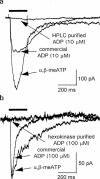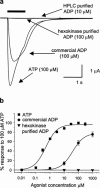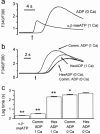ADP is not an agonist at P2X(1) receptors: evidence for separate receptors stimulated by ATP and ADP on human platelets
- PMID: 10960076
- PMCID: PMC1572284
- DOI: 10.1038/sj.bjp.0703517
ADP is not an agonist at P2X(1) receptors: evidence for separate receptors stimulated by ATP and ADP on human platelets
Abstract
ADP, an important agonist in thrombosis and haemostasis, has been reported to activate platelets via three receptors, P2X(1), P2Y(1) and P2T(AC). Given the low potency of ADP at P2X(1) receptors and recognized contamination of commercial samples of adenosine nucleotides, we have re-examined the activation of P2X(1) receptors by ADP following HPLC and enzymatic purification. Native P2X(1) receptor currents in megakaryocytes were activated by alpha, beta-meATP (10 microM) and commercial samples of ADP (10 microM), but not by purified ADP (10 - 100 microM). Purified ADP (up to 1 mM) was also inactive at recombinant human P2X(1) receptors expressed in Xenopus oocytes. Purification did not modify the ability of ADP to activate P2Y receptors coupled to Ca(2+) mobilization in rat megakaryocytes. In human platelets, P2X(1) and P2Y receptor-mediated [Ca(2+)](i) responses were distinguished by their different kinetics at 13 degrees C. In 1 mM Ca(2+) saline, alpha,beta-meATP (10 microM) and commercial ADP (40 microM) activated a rapid [Ca(2+)](i) increase (lag time < or =0.5 s) through the activation of P2X(1) receptors. Hexokinase treatment of ADP shifted the lag time by approximately 2 s, indicating loss of the P2X(1) receptor-mediated response. A revised scheme is proposed for physiological activation of P2 receptors in human platelets. ATP stimulates P2X(1) receptors, whereas ADP is a selective agonist at metabotropic (P2Y(1) and P2T(AC)) receptors.
Figures





Similar articles
-
A study of P2X1 receptor function in murine megakaryocytes and human platelets reveals synergy with P2Y receptors.Br J Pharmacol. 2002 Jan;135(2):363-72. doi: 10.1038/sj.bjp.0704486. Br J Pharmacol. 2002. PMID: 11815371 Free PMC article.
-
Osteoblast responses to nucleotides increase during differentiation.Bone. 2006 Aug;39(2):300-9. doi: 10.1016/j.bone.2006.02.063. Epub 2006 Apr 17. Bone. 2006. PMID: 16616882
-
P2Y1-receptors in human platelets which are pharmacologically distinct from P2Y(ADP)-receptors.Br J Pharmacol. 1998 May;124(1):157-64. doi: 10.1038/sj.bjp.0701827. Br J Pharmacol. 1998. PMID: 9630355 Free PMC article.
-
The P2 receptors in platelet function.Semin Thromb Hemost. 2005 Apr;31(2):150-61. doi: 10.1055/s-2005-869520. Semin Thromb Hemost. 2005. PMID: 15852218 Review.
-
Regulation of platelet functions by P2 receptors.Annu Rev Pharmacol Toxicol. 2006;46:277-300. doi: 10.1146/annurev.pharmtox.46.120604.141207. Annu Rev Pharmacol Toxicol. 2006. PMID: 16402906 Review.
Cited by
-
Identification, characterization, and inhibition of the platelet ADP receptors.Int J Hematol. 2001 Dec;74(4):375-81. doi: 10.1007/BF02982079. Int J Hematol. 2001. PMID: 11794691 Review.
-
Platelet Ca(2+) responses coupled to glycoprotein VI and Toll-like receptors persist in the presence of endothelial-derived inhibitors: roles for secondary activation of P2X1 receptors and release from intracellular Ca(2+) stores.Blood. 2012 Apr 12;119(15):3613-21. doi: 10.1182/blood-2011-10-386052. Epub 2012 Jan 6. Blood. 2012. PMID: 22228626 Free PMC article.
-
Acetylsalicylic acid enhances purinergic receptor-mediated outward currents in rat megakaryocytes.Am J Physiol Cell Physiol. 2010 Mar;298(3):C602-10. doi: 10.1152/ajpcell.00422.2009. Epub 2009 Dec 30. Am J Physiol Cell Physiol. 2010. PMID: 20042731 Free PMC article.
-
ADP and AMP induce interleukin-1beta release from microglial cells through activation of ATP-primed P2X7 receptor channels.J Neurosci. 2002 Apr 15;22(8):3061-9. doi: 10.1523/JNEUROSCI.22-08-03061.2002. J Neurosci. 2002. PMID: 11943809 Free PMC article.
-
Molecular identification and characterization of the platelet ADP receptor targeted by thienopyridine antithrombotic drugs.J Clin Invest. 2001 Jun;107(12):1591-8. doi: 10.1172/JCI12242. J Clin Invest. 2001. PMID: 11413167 Free PMC article.
References
-
- BEZPROZVANNY I., EHRLICH B.E. The inositol 1,4,5-trisphosphate (InsP3) receptor. J. Memb. Biol. 1995;145:205–216. - PubMed
-
- BOARDER M.R., HOURANI S.M.O. The regulation of vascular function by P2 receptors: multiple sites and multiple receptors. TIPS. 1998;19:99–107. - PubMed
-
- BOEYNAEMS J.-M., COMMUNI D., SAVI P., HERBERT J.M. P2Y receptors: in the middle of the road. TIPS. 2000;21:1–3. - PubMed
-
- BOEYNAEMS J.-M., PEARSON J.D. P2 purinoceptors on vascular endothelial cells: physiological significance and transduction mechanisms. TIPS. 1990;11:34–37. - PubMed
-
- BORN G.V.R. Aggregation of blood platelets by adenosine diphosphate and its reversal. Nature. 1962;194:927–929. - PubMed
Publication types
MeSH terms
Substances
LinkOut - more resources
Full Text Sources
Other Literature Sources
Miscellaneous

